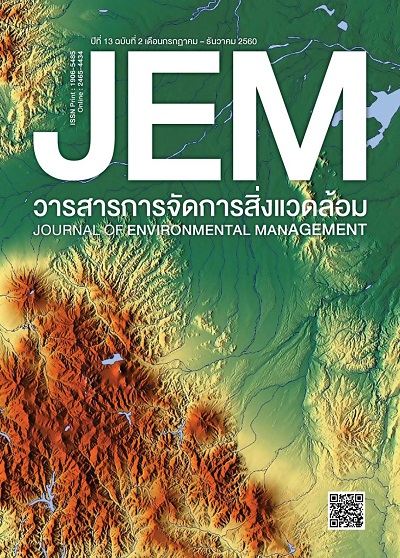ผลกระทบต่อเศรษฐกิจภาคครัวเรือนของชุมชนประมงพื้นบ้านจากการบริหารจัดการประตูระบายน้ำอุทกวิภาชประสิทธิในพื้นที่ลุ่มน้ำปากพนัง จังหวัดนครศรีธรรมราช IMPACTS OF THE UTOKVIBHATPRASIT IRRIGATION GATE MANAGEMENT ON THE HOUSEHOLD ECONOMY OF ARTISANAL FISHING
บทคัดย่อ
การวิจัยครั้งนี้มีวัตถุประสงค์เพื่อศึกษาสภาพเศรษฐกิจภาคครัวเรือนของชาวประมงพื้นบ้านในพื้นที่ลุ่มน้ำปากพนัง อำเภอปากพนัง จังหวัดนครศรีธรรมราช และอธิบายสภาพปัญหา รวมทั้งผลกระทบทางเศรษฐกิจที่มีต่อชุมชนชาวประมงพื้นบ้านจากการบริหารจัดการประตูระบายน้ำอุทกวิภาชประสิทธิ โดยใช้กระบวนการวิจัยแบบมีส่วนร่วม ด้วยการสำรวจพื้นที่ การตอบแบบสอบถาม การสัมภาษณ์ การประชุมกลุ่มย่อย และการสังเกตแบบมีส่วนร่วมกลุ่มตัวอย่าง ได้แก่ ชาวประมงพื้นบ้าน 301 ครัวเรือน ผู้นำท้องถิ่น 5 คน รวมทั้งปราชญ์ชาวบ้านและผู้นำชุมชนอีก 38 คน พบว่า หลังมีประตูระบายน้ำฯ กลุ่มตัวอย่างส่วนใหญ่ (ร้อยละ 84.72) รู้สึกไม่มั่นคงในอาชีพ ภาพรวมรายจ่ายและหนี้สินครัวเรือนเพิ่มขึ้น (ร้อยละ 72.09 และร้อยละ 44.19) ร้อยละ 89.70 ต้องกู้เงินมาเป็นทุนในการทำอาชีพเสริม ทั้งจากธนาคารเพื่อการเกษตรและสหกรณ์การเกษตร ญาติพี่น้องและกองทุนหมู่บ้าน เฉลี่ยครัวเรือนละ 36,846.67 10,707.64 และ 8,108.33 บาท ตามลำดับ มีเพียง ร้อยละ 10.30 เท่านั้น ที่เชื่อว่าจะสามารถชำระคืนได้ตามสัญญาและกว่าครึ่งหนึ่ง (ร้อยละ 61.13) ไม่พอใจกรมชลประทานที่ขาดการสื่อสารและขาดความต่อเนื่องในการแก้ไขปัญหา หน่วยงานภาครัฐจึงควรบูรณาการการทำงานเพื่อพัฒนาอาชีพและเพิ่มรายได้ให้กับครัวเรือน รวมทั้งควรจัดหน่วยเคลื่อนที่พบปะและบริการชุมชน เพื่อสร้างความเข้าใจร่วมกันอย่างสม่ำเสมอและต่อเนื่อง
This research aimed to study the household economy of artisanal fishermen in the Pak Phanang River Basin, Pak Phanang District, Nakon Si Thammarat, as well as to explore problems and economic impacts of the Utokvibhatprasit Irrigation Gate management on artisanal fishing communities. The research instruments consisted of participatory action research, area surveys, questionnaires, interviews, focus group, and participant observation. Sample groups include 301 artisanal fishing households, 5 local leaders, and 38 folk scholars and community leaders. The findings revealed that after the building of the Utokvibhatprasit Irrigation Gate, most of the artisanal fishermen (84.72%) felt insecure about their occupation, there was an increase in overall household expenses (72.09%) and debts (44.19%), and 89.70 percent had to do extra work to supplement their ordinary income. While the average household loan debts for investment from the Bank for Agriculture and Agricultural Cooperatives, relatives, and village funds were 36,846.67; 10,707.67, and 8,108.33 baht respectively, only 10.30 percent were likely to pay their debts by the due date. Nevertheless, 61.13 percent were not satisfied with the operation of the Royal Irrigation Department because of their negligence regarding problems and their lack of communication with the community. In order to deal with the current problems and impacts continually and effectively, an integrated approach should be used by the government sector. For career development and in order to increase household income, a mobile unit for public services should be available to maintain mutual understanding between the government and public sectors.
เอกสารอ้างอิง
Amphoe Pak Phanang. (2009). The General Data [In Thai]. Mimeographed document.
Assawaari, A., & Sriarun, P. (2003). Fishing effort in Pak Phanang River and its tributary [In Thai]. Bangkok: Department of Fisheries.
Craig, J. F. (2000). Large Dams and Freshwater Fish Biodiversity. Dumfries: World Commission on Dam.
Crown Property Bureau. (2013). Duay Phra Metta Plik Fuen Phatthana Loom Nham Pak Phanang [In Thai]. Bangkok: Daoreuk Communications.
Janjula, N. (2009). Dam: Development and fishery problem in Thailand [In Thai]. Journal of Humanities and Social Sciences, 5(2), 25 – 36.
Larinier, M. (2001). Environmental Issues, Dams and Fish Migration. FAO Fisheries Technical Paper, No. 419. Rome: Food and Agriculture Organization of the United Nations.
Marine and Coastal Resources Institute. (2004). Natural resources and environment management in The Royal-initiated Pak Phanang River Basin Development Project [In Thai]. Songkhla: Prince of Songkla University.
Prabnarong, P., & Kaewrat, J. (2006). The Uthokwiphatprasit Watergate: A Man-Made Change in Pak Phanang River Basin. Walailak Journal of Science and Technology, 3, 131-143.
Royal-initiated Pak Phanang River Basin Development Project. (2000). The Royal-initiated Pak Phanang River Basin Development Project [In Thai]. Nakhon Si Thammarat: Royal Irrigation Department.
Royal-initiated Pak Phanang River Basin Development Project. (2009). The master plan of The Royal-initiated Pak Phanang River Basin Development Project in 2010-2013 [In Thai]. Nakhon Si Thammarat: Royal Irrigation Department.
Suknual, T. (2007). Adaptation of local fisherman community in Pak Phanang River Basin after the Birth of Pak Phanang River Basin Development Project [In Thai]. Bangkok: Thailand Research Fund.
Thammachat, S. (2004). A study of the order of importance of problems and peoples’ needs for research into and development of the Pak Phanang Basin Region [In Thai]. Nakhon Si Thammarat: Walailak University.
Tipkonglas, N., Kwanmueng, S. & Thippayawong, S. (2000). Survey Situation fishing in the Pak Phanang River and its tributaries important [In Thai]. Bangkok: Department of Fisheries.
Vanichbuncha, K. (2003). Statistical analysis: Statistics for management and research [In Thai]. Bangkok: Chulalongkorn University.



